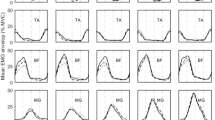Abstract
SmartCranks use a free running bearing to promote independent pedal work by each leg during cycling. This system is designed for training the upstroke phase during cycling. The effects of training with SmartCranks on the power output (PO) and on cycle work distribution at the anaerobic threshold and the maximum power level were examined. Twenty male, non-professional cyclists were randomly assigned into intervention and control group, training 5 weeks with SmartCranks and conventional cranks, respectively. Before and after the training period the subjects performed an incremental test to exhaustion. Lactate was measured to determine the individual anaerobic threshold (IAT) and forces at the pedal were recorded to quantify changes in the work distribution over the full revolution. We observed no significant statistical difference for peak power (PO; 333.3 ± 32.8 W vs. 323.3 ± 21.8 W) and PO at IAT (229.6 ± 30.1 W vs. 222.7 ± 25.2 W) for SmartCrank and control conditions, respectively (P > 0.05). However, we did observe that work distribution in the downward phase was significantly reduced in the SmartCranks training group at peak PO (from 70.0 ± 4.9% to 64.3 ± 5.8%; P < 0.05). Although the possible implications of the change in the work distribution of sectors are not known, for the success in cycling performance—indicated by the PO—training with the SmartCranks was not more advantageous than training with conventional bicycle cranks.










Similar content being viewed by others
References
Böhm H, Cole GK, Brüggemann GP, Ruder H (2006) Contribution of muscle series elasticity to maximum performance in drop jumping. J Appl Biomech 22:3–13
Bompa T (1999) Periodization, theory and methodology of training. Human Kinetics, Champaign, pp 60–63
Cohen J (1988) Statistical power analysis for the behavioral sciences, 2nd edn. Lawrence Erlbaum, Hillsdale, pp 20–28
Coyle EF, Feltner ME, Kautz SA, Hamilton MT, Montain SJ, Baylor AM, Abraham LD, Petrek GW (1991) Physiological and biomechanical factors associated with elite endurance cycling performance. Med Sci Sports Exerc 23:93–107
Coyle EF, Sidossis SF, Horowitz JF, Beltz JD (1992) Cycling efficiency is related to the percentage of Type I muscle fibers. Med Sci Sports Exerc 24:782–788
Davids K,Glazier P, Araujo D, Bartlett R (2003) Movement systems as dynamical systems. The functional role of variability and its implications for sports medicine. Sports Med 33:245–260
Davis RR, Hull ML (1981) Measurement of pedal loading in bicycling: II. Analysis and results. J Biomech 14:857–872
Faria IE (1992) Energy expenditure, aerodynamics and medical problems in cycling: an update. Sports Med 14:43–63
Hodges NJ, Franks IM (2002) Modelling coaching practice: the role of instruction and demonstration. J Sports Sci 20:793–811
Hue O, Galy O, Hertogh C, Casties JF, Prefaut C (2001) Enhancing cycling performance using an eccentric chainring. Med Sci Sports Excerc 33:1006–1010
Hull ML, Williams M, Williams K, Kautz S (1992) Physiological response to cycling with both circular and noncircular chainrings. Med Sci Sports Exerc 24:1114–1122
Kumagai S, Tanaka K, Matsuura Y, Matzusaka A, Hirakoba K, Asano K (1982) Relationships of the anaerobic threshold with the 5 km, 10 km, and 10 mile races. Eur J Appl Physiol 49:13–23
Lucia A, Balmer J, Davison RCR, Perez M, Santalla A, Smith PM (2004) Effects of the rotor pedalling system on the performance of trained cyclists during incremental and constant-load cycle-ergometer tests. Int J Sports Med 25(7):479–485
Luttrell MD, Potteiger JA (2003) Effects of short-term training using PowerCranks on cardiovascular fitness and cycling efficiency. J Strength Conditioning Res 17:785–791
Santalla A, Manzano JM, Perez M, Lucia A (2002) A new pedaling design: the rotor-effects on cycling performance. Med Sci Sports Exerc 34:1854–1858
Sanderson DJ (1987) Training with biofeedback. Real-time feedback improves pedalling style. Bike Tech 6:10–13
Sanderson DJ (1991) The influence of cadence and power output on the biomechanics of force application during steady-rate cycling in competitive and recreational cyclists. J Sports Sci 9(2):191–203
Sanderson DJ, Cavanagh PR (1990) Use of augmented feedback for the modification of the pedaling mechanics of cyclists. Can J Sport Sci 15:38–42
Schmidt R, Wrisberg C (1991) Motor learning and performance. Human Kinetics, Champaign
Simon G, Berg A, Dickhuth H, Simon-Alt A, Keul J (1981) Determination of anaerobic threshold depending on age and performance capacity. Dtsch Z Sportmed 32:7–14
Zameziati K, Mornieux G, Rouffet D, Belli A (2006) Relationship between the increase of effectiveness indexes and the increase of muscular efficiency with cycling power. Eur J Appl Physiol 96:274–281
Zamparo P, Minetti A, Prampero P (1981) Mechanical efficiency of cycling with a new developed pedal-crank. J Biomech 35:1387–1398
Acknowledgments
We thank the SmartCranks GmbH and the TOUR-magazine for providing the equipment used in the study.
Author information
Authors and Affiliations
Corresponding author
Rights and permissions
About this article
Cite this article
Böhm, H., Siebert, S. & Walsh, M. Effects of short-term training using SmartCranks on cycle work distribution and power output during cycling. Eur J Appl Physiol 103, 225–232 (2008). https://doi.org/10.1007/s00421-008-0692-z
Accepted:
Published:
Issue Date:
DOI: https://doi.org/10.1007/s00421-008-0692-z




